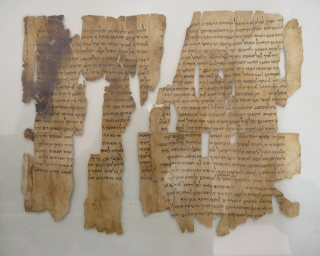The History Of Papyrus
Papyrus is one of the earliest materials to have been used as a surface for writing. It takes its name from its source; the plant Cyperus Papyrus, an aquatic herbacious perennial native to Africa. The conditions in the marshes around the Nile Delta in Egypt provided the perfect environment for this member of the sedge family to grow as it requires fresh water or water saturated ground to flourish. Papyrus plants have long thin stalks and are topped with feathery umbels and small brown fruit bearing flowers. In around 3000BC the Egyptians discovered a way to make an inexpensive and relatively durable writing surface from the pith contained within the stalks of the plant. Papyrus was utilized to create all types of documents, including the description of the last years of building of the Great Pyramid at Giza which concluded in 2560 BC.
Making Papyrus

Papyrus plant.
Whilst there is debate about the exact process used to make Papyrus sheets, the most detailed historical data is from Pliny the Elder (AD23-79) in his Naturalis Historia (Natural History). In this, Pliny details the technique of cutting lengthways the long thin stalks and separating the head and foot, leaving shoots which were then peeled to reveal sticky, fibrous inner triangular strips of pith. It is believed the Pharaonic Egyptians preferred thinner papyrus made from the base of the stalks as more pulp was contained there and that Romans and Greeks preferred papyrus sheets made from the middle section of the stalks. Once the strips were cut to approximately 40cm (16ins) long they were laid out with edges overlapping; the first vertically and on top another layer laid horizontally to create a grid pattern. These may have been dampened down and glued together before hammering out to effectively pulp the two layers together before drying under pressure. Once dried the sheets were polished by a rounded stone or shell to create a more even surface on which to write. In order to create manageable scrolls a wooden stick was attached to one end, made up of around ten to twenty sheets glued together.
Papyrus was first used sometime in the third or fourth millenia BCE, with documents haing been dated to 2560-2550BCE. Papyrus use spread across Europe and was in regular use until the 7th and 8th centuries. How far north Papyrus spread is unknown but it was fragile and easily damaged by the moisture often found in Northern Europe. In Europe papyrus was replaced by cheaper and more durable parchment, it's last dated use being for a papal decree in 1057.
Usage Over Time

Writing on papyrus from Amman.
Although papyrus was used extensively throughout Europe until the Middle Ages (last papyrus Papal Bull: 1022) it proved less durable than alternatives and suffered earlier decomposition in the less arid climate of Northern Europe than in Egypt. Whilst there is no doubt of the value placed on papyrus by the Egyptians, who used it to create and record for millenia and which became a standard in Greece and the Roman Empire; ultimately, vellum/parchment and paper superceded it. By the twelfth century, paper, introduced from China and vellum were in more general use and scholars had adopted the codex form a long time before this. Sheets were cut from papyrus rolls and folded and glued together to form pages. Codices were easier to handle and store than scrolls and could contain much more information in one codex or manuscript book than on a single scroll.

Papyrus with written mathematical proof.
As production of the less fragile and cheaper paper and vellum developed, papyrus use as a medium for document making, gradually declined. Small scale papyrus production, largely for the tourist trade, takes place in Egypt and also in Syracuse, Sicily. Papyrus is still utilised for the creation of artefacts and boats in parts of Africa where swamp conditions allow the plant to thrive.




